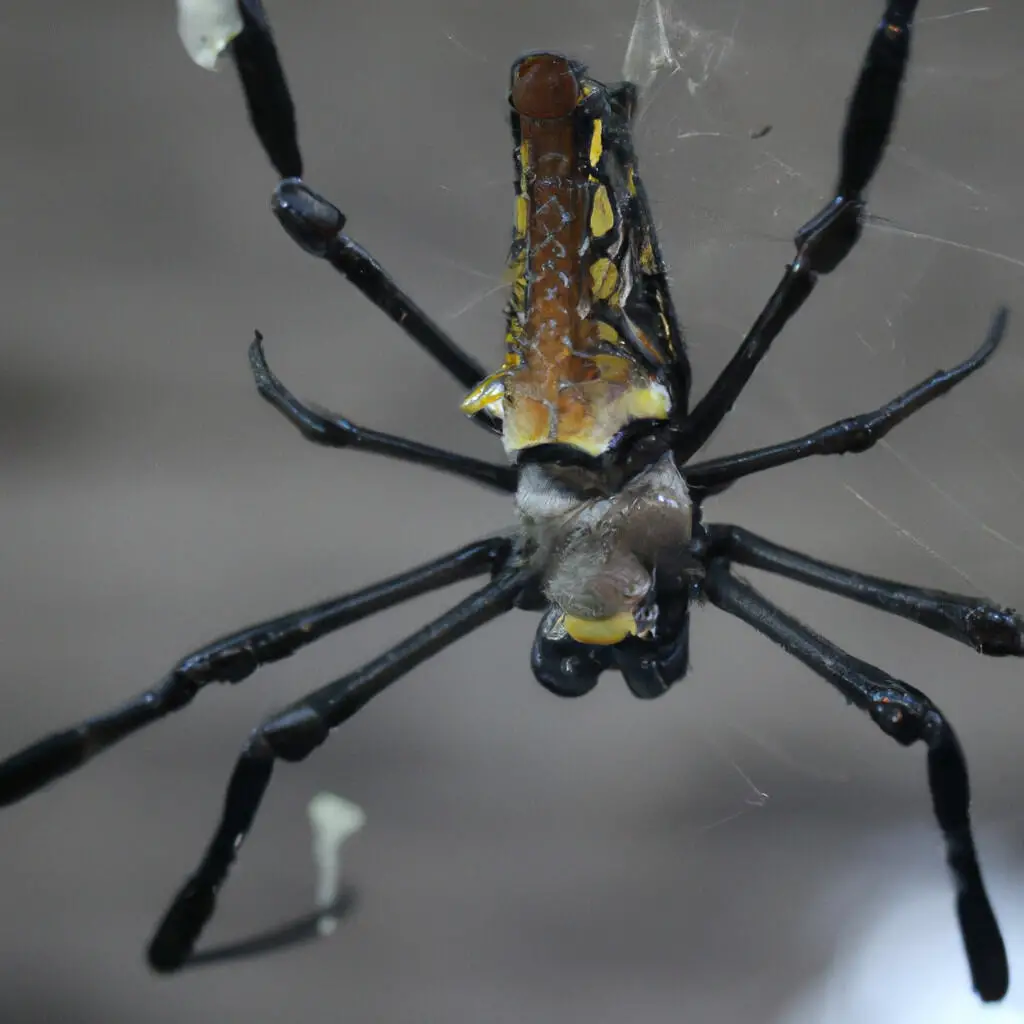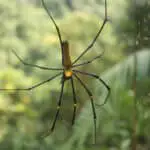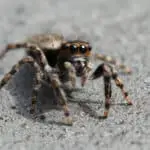Joro spiders are an invasive pest that can be a nuisance to homeowners. These spiders are known for their large size and aggressive behavior towards other spiders and even hummingbirds. If you’re dealing with a Joro spider infestation, it’s important to know how to get rid of them effectively and safely.
There are several methods for getting rid of Joro spiders, including physical removal, chemical treatments, and calling in a professional pest control service. Each method has its pros and cons, so it’s important to choose the one that works best for your situation. In this article, I will discuss the different methods for getting rid of Joro spiders and provide tips on how to prevent them from returning.
Key Takeaways
- Joro spiders are an invasive pest that can be a nuisance to homeowners.
- There are several methods for getting rid of Joro spiders, including physical removal, chemical treatments, and calling in a professional pest control service.
- To prevent Joro spiders from returning, it’s important to keep your home clean and free of clutter, seal up any cracks or gaps in your home’s exterior, and remove any potential sources of food or shelter.

Understanding Joro Spiders
As the name suggests, Joro spiders are a type of spider belonging to the Araneidae family. They are also known by their scientific name, Trichonephila clavata. These spiders are native to Japan and East Asia and were first documented in the United States in 2014 in northeast Georgia. Since then, the spider has spread about 75 miles in all directions from the initial detection.
Joro spiders are known for their large size, with females growing up to 3 inches long. They have a bulbous body with bright yellow stripes and distinctive red markings on their underbelly. Joro spiders weave large webs that look like a beautiful work of art.
Joro spiders are not venomous and pose no threat to humans. However, they can be a nuisance when they build their webs around homes, gardens, and other outdoor areas. They can also be a threat to other insects and small animals that get caught in their webs.
It is important to note that killing Joro spiders is not necessary unless they are causing significant problems. Instead, it is recommended to simply relocate them to a more appropriate location away from homes and gardens.
If relocation is not an option, there are several effective methods for getting rid of Joro spiders. These include physical removal, vacuuming, and the use of natural remedies such as tobacco juice and lemon dish soap mixed in a hose-end sprayer. It is important to consistently apply these methods to see results.
In summary, Joro spiders are a type of spider that can be a nuisance when they build their webs around homes and gardens. However, they are not venomous and pose no threat to humans. If necessary, there are several effective methods for getting rid of them.
Physical Characteristics of Joro Spiders
Joro spiders are a type of arachnid that can be identified by their unique physical characteristics. In this section, I will discuss the size, color, body structure, and other relevant features of Joro spiders.
Size and Color
Joro spiders are known for their large size, with their legs alone extending up to 4 inches. Female Joro spiders are larger in size with 1-inch bodies that are blue-gray and yellow in color with red markings on their abdomen and legs. Their long legs are black with yellow bands. Males are smaller and mostly brown in color. Their body length is cylindrical in shape and they have a cephalothorax that is tan or blue-black in color.
Body Structure
The body structure of Joro spiders is unique. They have eight legs and two body parts – the cephalothorax and the abdomen. The cephalothorax is the head and thorax combined, while the abdomen is the rear part of the spider’s body. The legs of Joro spiders are long and slender, and they use them to move around and capture prey.
Joro spiders have a unique zigzag web pattern that they use to catch their prey. Their webs are typically found in corners of rooms, ceilings, and other dark places.
In conclusion, Joro spiders have unique physical characteristics that make them easy to identify. Their large size, unique coloration, and body structure make them stand out from other spiders. By understanding their physical characteristics, you can take the necessary steps to control and eliminate them from your home.
Geographical Distribution of Joro Spiders
Joro spiders, also known as Nephila clavata, are native to East Asia, particularly Japan and Southeast Asia. These spiders are known for their ballooning behavior, which involves using their silk to catch the wind and travel long distances. This behavior has allowed Joro spiders to spread to new areas, including shipping containers that are transported around the world.
Origin and Spread
Joro spiders were first reported in the United States in 2009 in Georgia. Since then, they have spread to other states in the Southeast, including South Carolina and North Carolina. There have also been reports of Joro spiders in Tennessee and Oklahoma. Given their ability to travel long distances and their presence in shipping containers, it is possible that Joro spiders could continue to spread to other parts of the United States.
Joro Spiders in the United States
Joro spiders have become a concern in the United States because they are larger than many native spider species and their webs can be quite large. While Joro spiders are not considered dangerous to humans, their presence can be a nuisance, particularly if they are building webs in areas where people frequently walk or work.
To manage Joro spider populations, the most direct approach is to kill them. Wrapping them up in their web and stepping on them is a very effective technique. Simply destroying the web is not effective, as they can rebuild it quickly. In Northeast Georgia, experts recommend using a vacuum cleaner to remove Joro spiders and their webs from buildings and other structures.
In conclusion, Joro spiders are an invasive species in the United States that have the potential to spread to other parts of the country. While they are not dangerous to humans, their presence can be a nuisance. To manage Joro spider populations, it is important to kill them directly and to remove their webs from structures.
Joro Spiders and Their Webs
As the name suggests, Joro spiders are known for their large webs that they spin to catch their prey. These webs are made of a special silk called golden silk, which is stronger and more durable than regular spider silk.
Joro spiders are native to East Asia but have recently invaded warm regions of the United States, including Georgia. These spiders are larger in size than most spider species found in the US, giving them a threatening appearance.
The webs of Joro spiders are often found in outdoor areas such as gardens, porches, and decks. They can also be found inside homes and buildings. The webs are usually large and messy, making them an eyesore and a nuisance to homeowners.
Removing Joro spiders and their webs is important not only for aesthetic reasons but also to prevent the spiders from multiplying and potentially causing harm.
There are several methods for removing Joro spiders and their webs, including physical removal and the use of pesticides. It is important to note that the use of pesticides should be a last resort and should only be used by professionals.
In summary, Joro spiders and their webs can be a nuisance to homeowners and should be removed promptly. There are several methods for removal, but it is important to prioritize non-toxic and environmentally friendly options whenever possible.
Are Joro Spiders Dangerous?
As a spider enthusiast, I understand that some people may have concerns about the potential dangers of Joro spiders. So, let’s address the question on everyone’s mind: Are Joro spiders dangerous?
The short answer is no. According to NPR, Joro spiders are harmless to humans, and while they do use venom to kill their prey, that venom is not harmful to people. In fact, even if you were to be bitten by a Joro spider, the bite would be no worse than a bee sting.
However, as with any insect or arachnid, there is always the potential for an allergic reaction. If you are allergic to spider bites or bee stings, it is important to take the necessary precautions when dealing with Joro spiders.
It is also important to note that Joro spiders are not aggressive towards humans. They are shy creatures that prefer to avoid confrontation. So, unless provoked, they are unlikely to bite.
In summary, Joro spiders are not dangerous to humans. While they do use venom to kill their prey, that venom is not harmful to people. However, if you are allergic to spider bites or bee stings, it is important to take the necessary precautions.
Joro Spiders as a Nuisance
As much as we love nature, no one wants to share their home with unwanted guests. Unfortunately, Joro spiders can be a nuisance for homeowners in the Southeastern United States. These invasive spiders are known for building large webs in outdoor areas like decks, gardens, and porches.
If you have a Joro spider problem, you may notice an increase in spider activity around your home. While they are not dangerous to humans, their presence can be unsettling and unsightly. Additionally, Joro spiders can be tough to eradicate once they’ve established a comfortable nest in your home.
To avoid a spider infestation, it’s essential to take preventative measures. Start by sealing any cracks or gaps in your home’s exterior to prevent spiders from entering. Keep outdoor areas clean and free of debris to discourage spiders from building webs.
If you already have a Joro spider problem, there are several methods you can use to get rid of them. Physical removal by vacuuming, sweeping, or by hand is an effective way to eliminate spiders and their webs. You can also use insecticides or natural remedies like essential oils to repel spiders.
In conclusion, Joro spiders can be a nuisance for homeowners in the Southeastern United States. By taking preventative measures and using effective removal methods, you can keep these invasive spiders from taking over your home.
How to Get Rid of Joro Spiders
If you’ve found yourself with a Joro spider infestation, you’re likely wondering how to get rid of them. Fortunately, there are a few effective methods you can try.
One option is to physically remove the spiders and their webs from your home using a vacuum cleaner, broom, or by hand. This can be a time-consuming process, but it’s a good way to ensure that you’ve eliminated all the spiders from your home.
Another option is to use insecticides. However, it’s important to use these carefully, as they can be harmful to humans and pets. If you’re not comfortable using insecticides yourself, it’s best to call in a pest control professional.
In addition to these methods, there are some preventative measures you can take to keep Joro spiders out of your home. Seal up any cracks, gaps, or holes around windows, doors, and other openings in your home. Install door sweeps and make sure window screens are in good repair.
By following these tips, you can effectively get rid of Joro spiders and keep them from coming back.
Joro Spiders in Research and Science
As the Joro spider continues to spread across the United States, researchers and scientists have been studying the spider’s behavior and physiology to better understand how to manage and control the population.
Physiological entomology is one area of research that has been particularly useful in understanding the Joro spider. Researchers have found that the spider’s venom contains a neurotoxin that can cause paralysis in insects and other small prey. This has led to the development of new insecticides that target the spider’s nervous system and can effectively control the population.
Another area of research that has been helpful in managing the Joro spider is citizen science. Platforms like iNaturalist allow individuals to report sightings of the spider and contribute to a larger database of information on the spider’s distribution and behavior. This information can then be used by researchers and scientists to better understand how the spider is spreading and how to effectively manage its population.
Despite these research efforts, there is still much to be learned about the Joro spider and its impact on the ecosystem. Ongoing research and collaboration between scientists, researchers, and the public will be critical in managing and controlling the Joro spider population in the United States.
Interesting Facts About Joro Spiders
As you prepare to get rid of joro spiders, it’s important to know a few interesting facts about these arachnids. Here are some things you may not know about joro spiders:
- Joro spiders are also known as golden orb weavers, due to the beautiful golden color of their silk.
- Juvenile joro spiders are often a bright green color, which can make them difficult to spot in foliage.
- Female joro spiders can lay up to 1,000 eggs in a single egg sac, which can be as large as a golf ball.
- Joro spiders are native to India and other parts of Asia, but have recently been found in the southeastern United States.
- While joro spiders are venomous, their bites are not usually harmful to humans. In fact, they are not aggressive unless provoked.
- Joro spiders are known for their impressive web-building skills. Their webs can be up to three feet in diameter and are incredibly strong.
Knowing these facts about joro spiders can help you better understand these creatures and how to deal with them.
Frequently Asked Questions
What are Joro spiders and why are they a pest?
Joro spiders are a species of orb-weaving spider that are native to Asia but have become invasive in many parts of the world, including the United States. They are considered pests because they can build large webs that are unsightly and can be a nuisance to people who walk into them. Additionally, Joro spiders have been known to bite humans, although their venom is not considered dangerous.
How big can Joro spiders get?
Joro spiders are relatively large spiders, with females growing up to 2 inches in length and males growing up to 1 inch in length. They have distinctive markings, with a yellowish-orange body and black and white stripes on their legs.
What do Joro spiders eat and where do they live?
Joro spiders primarily eat insects, including moths, flies, and beetles. They typically live in wooded areas and build their webs on trees, shrubs, and other vegetation. However, they can also build webs on man-made structures, such as houses and fences.
What is the best way to get rid of Joro spiders?
The best way to get rid of Joro spiders is to remove their food sources and their webs. This can be done by cleaning up any piles of leaves, sticks, or other debris from around the outside of your home and trimming back any out-of-control vegetation around the outside of your home. Additionally, physically removing Joro spiders and their webs from your home can be effective, although it doesn’t address the root of the problem.
Should you kill Joro spiders?
While Joro spiders can be a nuisance, they are not considered dangerous to humans and play an important role in controlling insect populations. Therefore, it is generally not necessary to kill Joro spiders unless they are causing significant problems.
Can bug spray or a salt gun kill Joro spiders?
Bug spray and salt guns are not effective at killing Joro spiders. Instead, the best way to get rid of Joro spiders is to remove their food sources and their webs, as mentioned above.







